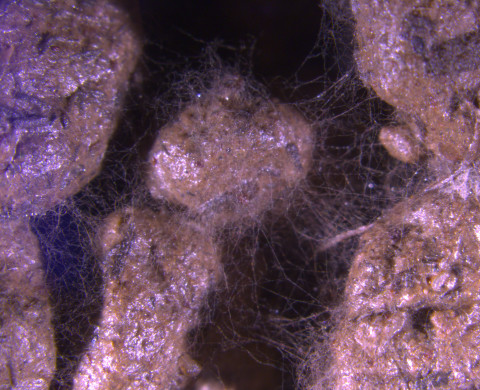Carbon storage in nature

Carbon is everywhere. It is continually recycled. This influences our climate, but also agriculture. NIOO scientists study what drives this carbon cycling.
Carbon is one of the main elements on earth. In the form of carbon dioxide, methane and organic compounds, it is continually recycled by plants and microbes and exchanged between air, soil and water. As such, carbon is a major player in climate change and is vital for plant health and productivity. Researchers at NIOO study how these cycles work -- and how to influence them.
Carbon is omnipresent in our living and non-living environment. It is continually being recycled between organisms, soil, air and water. “In fact there is not one cycle, but rather a network of interconnected carbon cycles”, says Paul Bodelier, senior scientist at the NIOO department of Microbial Ecology. “These cycles are tremendously important for life on earth. They govern the flow of nutrients and energy, but also affect our climate.”
Plants and other primary producers take up carbon dioxide from the air or water, and fix it into organic compounds in a process called photosynthesis. These organic compounds include sugar and other carbohydrates, as well as lipids and a range of other compounds. This carbon fixation is the starting point for a range of food web interactions, with animals and microbes consuming the organic carbon and producing carbon dioxide or methane in the process. Both are important greenhouse gases. Along the way, carbon is also ‘leaked’ into water and soils. There, it feeds other organisms, and affects plant productivity and greenhouse gas emissions.
Carbon cycles are driven by a wide variety of factors – biotic factors, such as biodiversity and the nature of food webs, but also abiotic factors, such as temperature or the presence of water and certain nutrients. At NIOO, scientists try to unravel these complex relationships. Ultimately, they hope to be able to steer these relationships, improving the healthy functioning of soils, and thereby crop productivity and carbon sequestration .
There are still many unknown parts of the carbon cycle.
Surprising effects
There are some surprising feedback effects in the various carbon cycles. “This is something we are only just starting to discover”, says Bodelier. His NIOO colleague Kyle Mason-Jones, postdoc at the Terrestrial Ecology department, names an example: a so-called priming effect. ‘’If you add carbon to the soil, in some cases the amount of carbon in the soil will actually decrease.” This, as he explains, is because the extra carbon may promote the growth of certain micro-organisms that break down organic matter that is already present in the soil, releasing carbon dioxide into the air.
Similarly, if you add nitrogen or phosphorus to sediment or soil, microbial oxidation of methane may increase, thus removing methane from the system. “But we still know very little about how this works, exactly”, says Bodelier. “There may be biotic or abiotic preconditions that we don’t know about, such as specific requirements of the microbes involved.”
Processes in conjunction
Dedmer van de Waal, senior scientist at the Aquatic Ecology department, adds another example. Excess phosphate or nitrate may cause eutrophication in freshwater systems, which promotes algal growth. “In these circumstances, the sediments become more easily anoxic, causing relatively larger amounts of methane to be released”, he says. “Apparently, a shift in the type of primary producers like aquatic plants or algae may lead to carbon being released in a different form.”
Scientists at NIOO always try to look at these processes in their wider context, emphasises Ciska Veen, tenure track researcher at the Terrestrial Ecology department. “If we want to understand one process, we have to look at other processes as well. And the next step is that we want to learn how to steer those processes.”
Long-term storage
A lot of the world’s carbon is stored for a long time in various forms, thus being unavailable for the short-term carbon cycles. Examples include dead wood and other plant materials in forests soils, plant material in peatlands, or dead organic matter that has sunk to the ocean floor. But also root exudates: sugary compounds that plant roots excrete into the soil. “This carbon may be stored for over a thousand years”, says Veen. “But eventually, it always becomes part of the food web again. The rate at which this happens has an effect on climate, but also on agriculture.”
Veen’s colleague Mason-Jones studies the relationships between soil microbial biomass and different forms of organic matter stored in the soil. “Viruses play an unexpected role in this context”, he says, “because they have an impact on ecological balance between different microbial communities, such as bacteria and fungi.”
Steering the cycles
Veen and Mason-Jones are both interested in how different forms of agriculture – for instance modern versus more traditional or organic agriculture – impact these microbial balances, and hence influence the carbon cycles. “In our Vital Soils project, we experiment with various kinds of agriculture on actual farms”, says Veen, “in close collaboration with farmers. They are interested in trying to steer carbon cycles – not just in the context of greenhouse gas emissions, but also because of the link between carbon cycles and plant productivity and resilience.”
Contrary to what you might assume, high microbial activity does not always lead to more breakdown and carbon loss, as Veen remarks. “Actually, it can lead to more microbial biomass production which can be bound to the soil matrix. This carbon is then quite stable. Recent research has revealed this mechanism, and we are now studying if we can manage microbial communities in such a way that ultimately, more carbon is stored via this pathway.”
Bodelier highlights another NIOO project, which was recently completed. “So-called cover crops are often grown on fields in autumn and winter and then ploughed into the soil as green manure”, he says. “We studied how mixtures of cover crops and affect micro-organisms in the soil, and how this contributes to carbon storage and the reduction of greenhouse gas emissions. In a follow-up project, we want to build on this knowledge to make agriculture more climate-friendly.”
Reversing adverse effects
In another project, the NIOO researchers are studying how to stimulate the growth of micro-organisms that take up methane from the air, in order to reduce the concentrations of this potent greenhouse gas. “Adding compost or other organic residues to soil proved to increase methane uptake from the air”, says Bodelier. “This naturally happens in nature, but agriculture has decreased the ability of soil ecosystems to remove methane from the air. Understanding why this is, and reversing this effect through targeted interventions, would be a major step forward.”
These interventions could imply restoring the natural ecological functions of agricultural systems, for instance by increasing biodiversity and using multi-year crops. Van de Waal and Veen highlight several other NIOO projects at NIOO along the same lines: on climate-robust landscapes, climate-smart forestry, and food forests that store carbon, among other things.
“In the past ten to fifteen years, several novel biogeochemical reactions have been discovered that we didn’t know existed”, summarises Bodelier. “Many of them directly affect the carbon cycle. And there must be many more that we still don’t know about. Our main priority is to keep discovering those unknown parts of the carbon cycle.”
The next step is trying to steer these processes.
Experts
-
Paul Bodelier
Senior Researcher , Microbial Ecology
-
Ciska Veen
Head of department , Terrestrial Ecology
-
Dedmer Van de Waal
Senior Researcher , Aquatic Ecology
-
Kyle Mason-Jones
Researcher , Terrestrial Ecology
-
Steven de Goede
PhD Candidate , Terrestrial Ecology -
Wietse de Boer
Researcher , Microbial Ecology
-
Eiko Kuramae
Senior Researcher , Microbial Ecology
-
Justine Lejoly
Researcher | Tenure Track , Terrestrial Ecology
-
Steven Declerck
Senior Researcher , Aquatic Ecology
-
Nacho Villar
Postdoc , Terrestrial Ecology
Applications:
- Climate policy
- Nature management
- Soil management
-
- new projects
- Many
-
- carbon forms
- 3
-
- carbon emission/year
- How much





